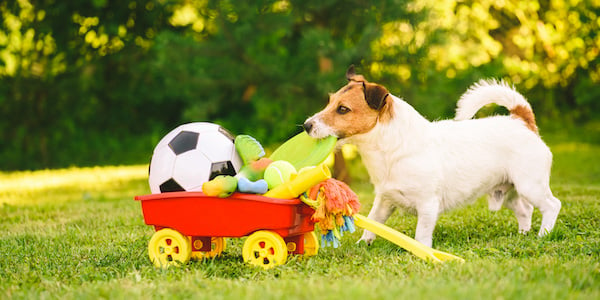

Separation anxiety is an anxiety disorder that affects 1 in 7 dogs (that's 13 million dogs in the United States alone!). It is a particular fear and state of worry that dogs experience when they are left alone or separated from a certain person.
Some dogs may become anxious when alone (often termed isolation distress), while others only exhibit anxiety when separated from a particular person, but are otherwise near other people (separation anxiety). There are varying levels of severity, but the dog is experiencing the equivalent of a panic attack in people.
In many cases, a dog will start to show anxious behaviors when they think they are about to be left alone due to the anticipation of being alone or away from their person. This may start quite a long time before someone actually leaves. Some dogs with separation anxiety are okay when their person leaves, but cannot handle more than a certain length of time alone.
When a dog is experiencing separation anxiety, the naturally occurring chemicals in the brain are out of balance. The sympathetic nervous system (a part of the autonomic nervous system) is activated, readying the dog to respond to the perceived "threat" with the fight, flight, or freeze responses.
The release of hormones (such as cortisol and adrenaline) floods their brain and causes physiological responses that include increased heart rate, alertness, and more blood flow to muscles so they are ready to act. This state of mind is exhibited by the measurable physical symptoms of separation anxiety.
"These physical expressions of the panic and anxiety a dog is feeling aren't voluntary," says Cathy Madson, a certified canine behavior consultant. "A dog isn't being a 'bad dog' on purpose or to get back at you for leaving them alone. They really can't help themselves."
When a dog repeatedly experiences this state of panic, it becomes harder for their body to flush these chemicals and restore balance in the emotional processing centers of the brain. It becomes more difficult for them to return to a state referred to by behavior experts as "under threshold" — the state where they can successfully absorb behavior modification exercises and retrain their conditioned emotional responses to certain stimuli — in this case, being left alone.
Many things can contribute to a dog developing separation anxiety, including:
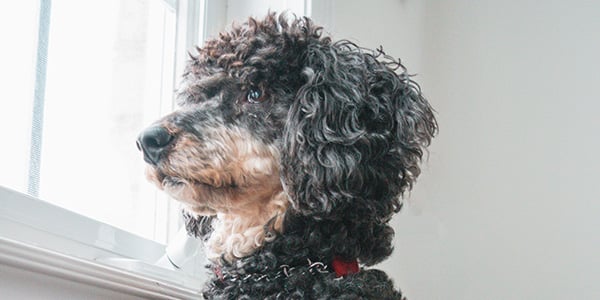
Some separation anxiety symptoms are more obvious than others. When evaluating a dog's symptoms to determine if it is in fact separation anxiety, it's important to consider if the dog only shows the majority of these behaviors when left alone or when separated from their attachment figure.
If they are also exhibiting these behaviors at other times, it might be a different type of anxiety, typical puppyhood or adolescent behaviors, a lack of training, or caused by an underlying medical issue.
The most common separation anxiety symptoms seen in dogs are:
More subtle signs of separation anxiety include:
Below are two videos showing examples of separation anxiety symptoms. Mabel Petrillo, a 10-year-old Pug exhibits vocalization and escapism behaviors at the gate. Mary Berry, a 1-year-old Mini Goldendoodle, exhibits clinginess, pacing, vocalization, and jumping at the doors and windows.
If your dog has separation anxiety, you'll want to connect with your veterinarian and a certified dog trainer or canine behavior consultant to begin anxiety management and treatment. Having both of these professionals as your support team will help you and your dog in a variety of ways, as they will help you with anxiety management and separation anxiety treatment.
Before treatment can begin, it is especially important to never leave your dog alone for longer than they can handle.
This may mean changing your schedule, asking friends or family members to watch your dog while you're away, enrolling in dog daycare (if your dog does well in that environment and doesn't become anxious), or hiring a pet sitter to be with your dog.
While this "absence suspension" may seem daunting, it's essential to make any real progress with separation anxiety treatment. Your dog trainer can help you create a support network.
Your veterinarian may recommend supplements or prescription medications to help manage your dog's separation anxiety. There are a variety of anti-anxiety medications, and your veterinarian will help you decide which may be best for your dog based on their health history and severity of symptoms.
If you have a senior dog, your veterinarian may also suggest medication support if canine cognitive dysfunction (doggie dementia) seems to be a contributing factor to their separation anxiety.
"The goal of anti-anxiety medications is not to 'cure' separation anxiety," says Cathy Madson, a certified dog trainer and behavior consultant. "Instead, they provide your dog's brain some relief, and that buffer makes management easier and actual treatment faster. In the majority of anxiety cases, bringing medications on board sooner is extremely beneficial to the behavior modification process."
Your dog trainer can also help you utilize other management tools, such as calming music, dog-appeasing pheromones, anxiety vests, or tPEMF devices. They may recommend changes to where your dog stays when left alone, such as no longer using a crate, or reducing the size of the dog's free-roaming area.
After reviewing your dog's daily routine with you, they may also recommend more enrichment activities and/or physical exercise.
Once you have implemented management for your dog's anxiety, then you can start treatment protocols with the help of your dog trainer.

Increasing your dog's daily enrichment activities can help prevent boredom and reduce overall stress and anxiety. Learn easy ways to incorporate more enrichment in your dog's routine.

Playing music can help your dog feel less anxious, and calm dogs with separation, travel, or noise anxiety. Read about what kind of music works best.
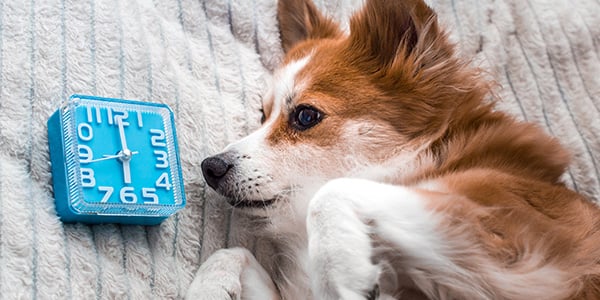
A daily routine is important not only for puppies but also to prevent issues such as separation anxiety. Here's how to introduce a routine to your dog.
Once you've created a management plan and mapped out how your dog will never be left alone, then it's time to start actual treatment of your dog's separation anxiety. Your certified dog trainer or behavior consultant will get you started on systematic desensitization and setting up video monitoring and recording.
Systematic desensitization is a process by which you slowly expose your dog to the things that typically cause their separation anxiety. The goal is to change their negative association of your departure and absence to a neutral association, through low-level exposure and repetition.
For example, if your dog shows subtle symptoms of anxiety when you put your shoes on, you will practice putting your shoes on and then taking them off. Your dog starts to unlearn that you putting your shoes on means you're always leaving, and it becomes a neutral action over time.
As you progress through systematic desensitization, you start adding in more of your departure routine. This could be putting your shoes on and then grabbing your keys, or putting your shoes on and then putting on your jacket. Over time, the process becomes your typical departure routine paired with short duration, and eventually longer duration, absences.
During this process, you never do more than your dog can handle. You only add on the next step of the routine when your dog is showing a neutral response to the previous step. In this video, you can see an example of what systematic desensitization looks like:
When working with your dog trainer to treat your dog's separation anxiety, you'll soon realize that you need an easy way to watch your dog via a pet camera and be able to record your training sessions. Your dog trainer will start off with taking a "baseline" – typically a one-minute-long recorded departure, often done live via a virtual call, to gauge your dog's anxiety symptoms and identify their initial anxiety trigger.
In order to prevent your dog from becoming anxious during treatment, you need to watch their body language for signs they are starting to worry, and immediately return before they exhibit more serious symptoms. Using a pet camera and watching live via the connected smartphone app makes this easier, and means that your treatment is the most effective.
Your trainer will be asking you to record and share your systematic desensitization sessions so they can review them throughout the process. They will coach you on where to start your desensitization repetitions (this is often much earlier in the departure process than most dog owners think it will be) and when to add in the next steps.
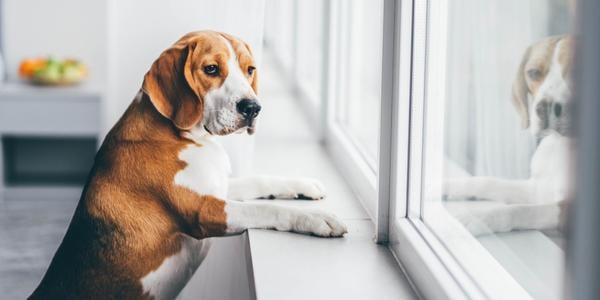
Learn how to set up a pet camera to help treat your dog's separation anxiety and how to share these videos with your dog trainer for effective training.

While food used to be utilized in treatment for separation anxiety for classical counterconditioning, an increasing number of behavior consultants are not including food-stuffed toys or other treats in their treatment plans anymore. Why is this?
If a dog is in a state of panic, they are not likely to even want the food, as their sympathetic nervous system activates their fight-flight-freeze responses and dampens their appetite. And in many cases, dogs who would eat were "stress eating" — eating so rapidly that it had no effect on their emotional response.
Food can distract some dogs when you leave but does nothing to ease their panic when they finish and realize you are gone. This makes establishing a dog's baseline and planning out initial treatment steps more difficult. Often, the act of grabbing a food-stuffed puzzle became an anxiety trigger for dogs, as it predicted their owner's departure.
To counteract these potential consequences of using food, behavior consultants now rely primarily on systematic desensitization. However, they will often recommend using food and treats as part of enrichment and other training exercises to help reduce overall stress and increase a dog's confidence.
Certified Dog Trainer Cathy Madson Talks About Separation Anxiety Treatment on New Day Northwest:
Share Your Experience
We'd love to hear about what has worked for you and your dog in treating their separation anxiety. Your feedback helps us provide the most effective education and recommendations for others, as well as inform behavior professionals on how to better help separation anxiety clients everywhere. We couldn't do it without input from the community.
The survey takes approximately 10-15 minutes to complete. As a thank you gift, upon completion of the survey, you'll receive a special coupon for our virtual Separation Anxiety Foundations Course.
Prevention is always preferable to treating separation anxiety after it has been diagnosed. But you should note that even with practicing preventive exercises, a dog may still suffer separation anxiety in the future — and it isn't your fault. There are many variables when it comes to what causes separation anxiety in dogs, many of which can be out of your control.
As introduced in the previous section about treatment, the process of systematic desensitization to alone time is also the main method of preventing separation anxiety from starting. You slowly introduce alone time in easy-to-handle "bite-sized" steps, building a neutral association with your absence. Ideally, introducing alone time is started when a dog is a young puppy and their brain is primed and ready to learn. But it's equally beneficial for newly adopted adult dogs who have not yet exhibited signs of separation anxiety.
Classical conditioning is the process by which you create positive associations with the experience of being alone. Classical conditioning is pairing your departure/absence with something good happening to your dog. For example, when you leave, your dog gets a delicious stuffed food puzzle to enjoy or gets to sniff out hidden treats. This method is used with dogs who do not already suffer from separation anxiety or isolation distress.
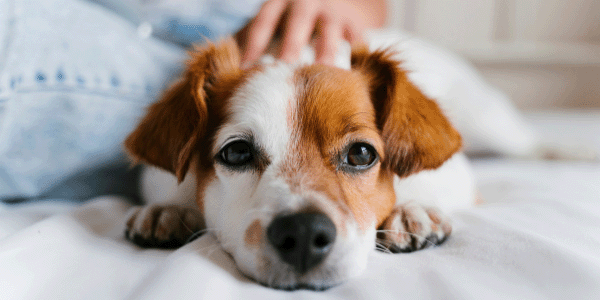
Learn how to teach your dog to be alone to prevent separation anxiety, build confidence, and reduce stress. Do these exercises with your new puppy or dog.
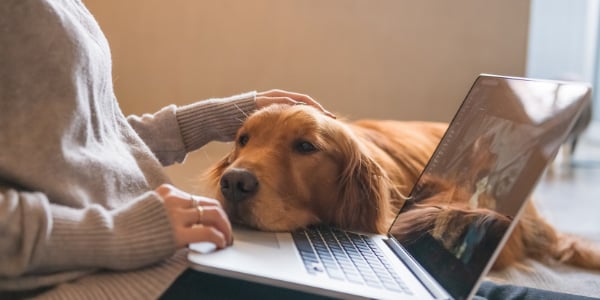
Dogs whose owners spend a lot of time at home can develop separation anxiety, if not addressed. There are simple steps to help prevent separation anxiety.
Crate training your dog may help prevent separation anxiety, as proper crate training is essentially teaching your dog to relax when confined and away from you. It's crucial to create positive associations with being in the crate and to work at your dog's pace when introducing the crate space, and crates should be used responsibly and never for extended periods of time.
For dogs who struggle with being confined in a crate — or have never been crate trained at all — it is not recommended to use a crate to help with their separation anxiety. This is layering on another factor of stress and often increases their anxiety response, as well as further poisoning their perception of the crate. Crate training is a long process, and to reduce your own workload, it's easier to focus primarily on systematic desensitization for separation anxiety rather than combine that with crate training protocols. In these cases, to protect your home, use a large exercise pen or gate-off a dog-proofed area for your dog to stay in.
However, if you have a new puppy or adopted dog who doesn't exhibit signs of separation anxiety and you want to help prevent it from developing, crate or pen training can be beneficial to provide a familiar and comfortable place for your dog to settle in while you're gone.
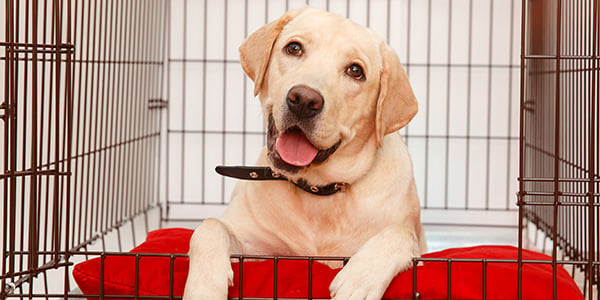
Wondering about the best way to crate train your puppy or adult dog? Learn how by following these easy steps to help your dog love being in their crate.
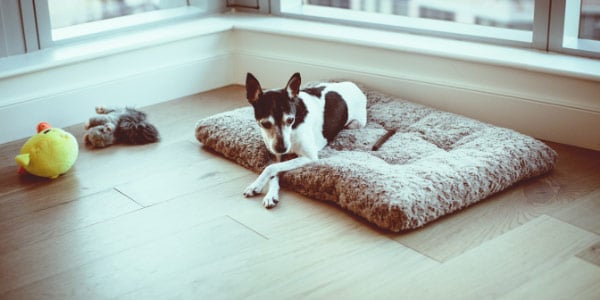
Learn how to set up a soothing safe space for your dog.

Make sure your dog's environment is as safe as possible when you leave your dog alone.
